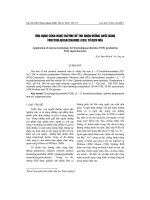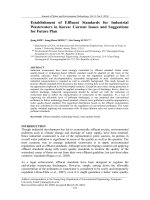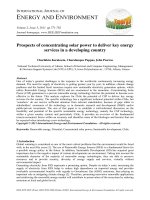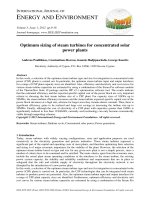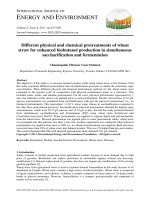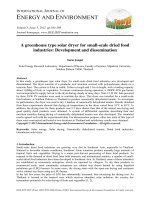Utilization of solar power for operating micro irrigation systems
Bạn đang xem bản rút gọn của tài liệu. Xem và tải ngay bản đầy đủ của tài liệu tại đây (330.14 KB, 6 trang )
Int.J.Curr.Microbiol.App.Sci (2019) 8(2): 3443-3448
International Journal of Current Microbiology and Applied Sciences
ISSN: 2319-7706 Volume 8 Number 02 (2019)
Journal homepage:
Original Research Article
/>
Utilization of Solar Power for Operating Micro Irrigation Systems
K.V.R. Rao*, P. Aherwar, P.C. Jena, K. Soni and S. Gangwar
Department of Irrigation and Drainage Engineering, ICAR-Central Institute of Agricultural
Engineering, Bhopal-462038, India
*Corresponding author
ABSTRACT
Keywords
micro irrigation
systems, Open well
submersible pump,
Solar power system
Article Info
Accepted:
29 January 2019
Available Online:
10 February 2019
Photovoltaic based electricity generation saves a major portion of renewable energy
generation in India. Ever increasing fuel cost and doubtful availability of electricity
hampers the irrigated crop production. Use of solar pump is an alternate to electric or
diesel pumps for irrigation of crops. This paper presents the utilization of solar power for
operating micro irrigation systems for irrigating field crops. An open well submersible
pump of 5hp capacity was operated by 4960Wp solar panel installed at ICAR-CIAE,
Bhopal for irrigation. The discharge rate of pump has been observed as 11400 to 24120 l/h
at a dynamic head of 2.5 m corresponding to solar irradiation range of 164 to 808 W/m 2
during time period from 8 am to 4 pm. The total power generation from the panel during
this period has been observed as 3013.5 W. The total excess power availability during
different irrigation treatments such as drip (T 1), portable sprinkler (T2), rain hose (T3) and
flood irrigation (T4) has been estimated for other uses of solar photovoltaic system. In
different irrigation systems the excess power availability range per year per ha has been
varies from 235 to 1160 kWh, 246 to 1213 kWh, 246 to 1213 kWh and 220 to 1084 kWh
respectively. The maximum area irrigated by T 1 of 2000 to 3500 m2, T2 800 to 2500 m2, T3
500 to 1500 m2, T4 100 to 450 m2.
Introduction
Indian economy is 6th largest developing
economies of the world and over 60% of
population depends on agriculture or allied
activities. Ever increasing fuel prices and
unreliable availability of electricity in villages
hampers the irrigated crop production in India.
In order to reap a good harvest, providing
appropriate moisture to the plant is a
necessary requirement. Over last two decades
the demand for electricity in irrigation is
growing up as the cost of an electric powered
pump is lower as compared to a diesel engine
driven pump. Though the demand for
electricity is increasing on supply side, the
availability of electricity is of limited duration
and during odd hours. It is therefore, solar
pump may be an alternate to address these
problems faced by farmers. The ranges of
solar radiation in India are between 4.0 and 7
kWh/m2 day with an annual radiation ranging
from 1200–2300 kWh per square meter and
the bright sunshine hours vary from 6 to 9
h/day (Yadav et al., 2015). Abu-Aligah (2011)
reported that in locations where electricity is
not available photovoltaic pumping system is
3443
Int.J.Curr.Microbiol.App.Sci (2019) 8(2): 3443-3448
a good option for irrigating crops and
supplying drinking water.
Namibia Renewable Energy Programme
(NAMREP) conducted a study on feasibility
of solar pumps in Namibia (Anon, 2006). The
report concluded that for small to medium
sized wells, a solar photovoltaic pump was
much cheaper (on a life cycle cost basis) than
a diesel-powered pump. When looking beyond
the original purchase price, solar pumping
systems costed from 22%-56% of diesel
pumps cost and could achieve a payback over
diesel engine operated pump in two years.
Hahn (2000) reported that in regions with high
insolation levels, photovoltaic pumping
systems were technically suitable for use,
beneficial for the environment and were
cheaper over the diesel engine driven pumps.
The use of solar powered irrigation systems
(SPIS) offers a chance to lower the energy and
water consumption under irrigation systems.
This is achieved through the use of solar
energy and the increased efficiency in water
application
(Williamson,
2006).
The
transportation of SPIS is simple compared to
other types of renewable energy systems
because the system can be transported in parts
and put together on site (Khatib, 2010).
Biswas and Hossain (2013) reported that
though the initial cost of a solar pump is
higher than a conventional diesel engine
operated pump, solar pump has lower
maintenance cost which makes it cost
effective over the years at the same time and a
solar pump is a pollution free and environment
friendly water pumping system. In many rural
areas, especially in developing and emerging
countries, the access to the electricity grid and
electricity availability is not always
guaranteed. Therefore, a study was undertaken
to utilize solar pump for operating micro
irrigation systems such as drip irrigation,
portable sprinkler irrigation and rain hose
irrigation systems.
Materials and Methods
A open well submersible pump of 5 hp
capacity operated by 4960 Wp solar panel
with two arrays (each consist of 8 panels) was
installed at Precision Farming Development
Center of ICAR- Central Institute of
Agricultural
Engineering,
Bhopal
for
irrigating field crops by different irrigation
treatments. The delivery lift of the pump is
2.5m. The performance of the pump was
tested by collecting the information on solar
radiation, generated voltage, current, lift,
discharge and other relevant data were
recorded for the pump. The daily flow rate of
the pump to deliver water for different
irrigation system over a period of time was
maintained by water meter. The solar
irradiation has been measured by using
pyranometer. The maximum area irrigated by
each irrigation system which is operated by
solar photovoltaic system has been measured
by operating micro irrigation systems
individually at a peak solar irradiation of 808
W/m2. The layout of solar power micro
irrigation system is presented in Figure 1.
The specializations of different micro
irrigation systems and solar pumping system
components uses are presented in table 1.
Results and Discussion
Performance of solar panel
The array of solar photovoltaic panels (SPV)
is capable of generating 4960 Wp under an
ideal condition. The actual range of power
generated by the SPV array is observed as
211-3563 W in a sunny day having solar
radiation of 58-975 W/m2. The total
generation efficiency of the system was
observed as 71.8% in the field condition. The
effective field efficiency of the system is
found to be 14.25%. The solar radiation from
April 2017 to March 2018 has been measured
3444
Int.J.Curr.Microbiol.App.Sci (2019) 8(2): 3443-3448
using pyranometer and analyzed. The data on
the basis of time has been observed (8 am to 6
pm) and presented month wise in the Figure
2. Maximum solar radiation has been
observed in the month of April 2017 is 902
W/m2 at 12 pm whereas minimum 365 W/m2
has been observed in the month of Aug 2017
corresponding to same time.
as 3.16 to 6.7 l/s at a dynamic head of 2.5 m
corresponding to solar insolation range of 164
to 808 W/m2 during time period from 8 am to
4 pm (Fig. 4). The total power generation
from the panel during this period has been
observed as 3013.5 W. The ambient
temperatures have been observed to be in the
range of 30-31 C.
Performance of pump
The maximum area covered under different
micro irrigation systems with solar power was
compared with solar powered conventional
(flood) irrigated area by operating each
irrigation system in a day corresponding to
solar radiation during 8 am to 4 pm. The same
is presented in Figure 5.
Variation of discharge of solar pump with
solar radiation at different times of a day was
tested in the project location and presented in
Figure 3. It is observed from the figure that
solar pump could not lift water below 60
W/m2 solar radiations. Discharge increased
with the increase of solar radiation and it
reached peak in the noon (12:00 am) and then
decreased gradually as solar radiation
decreased. During the testing period the
maximum discharge was found 7.35 l/s at
11.30 pm and average discharge was 3.67 l/s.
The discharge rate of pump has been observed
It can be seen from Figure 5 that the
maximum area irrigated by T1 is 2000 to 3500
m2, T2 800 to 2500 m2, T3 500 to 1500 m2 and
T4 100 to 450 m2 corresponding to solar
irradiation range of 164 to 808 W/m2 during
time period from 8 am to 4 pm.
Table.1 The specializations of different micro irrigation systems and solar pumping system
components uses
S.No Unit
Water Source
1
Pump
2
Drip irrigation
3
4
5
6
7
8
9
10
11
12
13
14
Portable sprinkler
Rain hose irrigation
Solar panel capacity
Total number of panels
Number of array
Max. output voltage
Max. power current
Input voltage
Working current
Output voltage
Frequency
Specification
Water Tank, 20,000 liter
5 hp, Open well Submersible pump (AC supply)
16 mm inline (0.40 m X 2 lph)
Lateral connected, mini sprinkler 70 lph
40 mm, 1 liter / minute / meter
4960 Wp
16
2
600-725 V
8.28 A
400-750 VDC
1-20 A
250-440 VAC, 3 Phase
0-60 Hz
3445
Int.J.Curr.Microbiol.App.Sci (2019) 8(2): 3443-3448
Figure.1 Layout of the solar power micro irrigation system, which indicates the different
parameters required for sizing the solar PV array and the pump
Solar
panel
Water
tank
Pump
controller
Open well
submersible
pump and
head unit
Flood
Irrigation
Drip
Irrigation
Sprinkler
Irrigation
Rain hose
irrigation
Flood
irrigation
Figure.2 Monthly average solar radiation
Figure.3 Variation of discharge of solar pump with solar radiation at different times of a day
3446
Int.J.Curr.Microbiol.App.Sci (2019) 8(2): 3443-3448
Figure.4 Power generated from SPV panel and discharge of pump
Figure.5 Area covers by irrigation system under different solar radiation respectively discharges
In conclusions, a solar powered irrigation
system is an alternate to conventional
powered
(electricity/diesel)
irrigation
systems. The study carried out at ICARCIAE, Bhopal indicates that the solar power
can be effectively utilized in irrigating field
crops using micro irrigation systems such as
drip, portable sprinkler and perforated pipes.
Use of solar power facilitated to cover
maximum area with drip irrigation followed
by portable sprinkler, where as conventional
flood irrigation resulted in covering lesser
area as compared to micro irrigation systems.
For the study area, the solar radiation required
to operate solar pump shall be more than 60
W/m2. The study also concludes that if the
installed solar panels exclusively used for
water pumping the effective field efficiency is
14.25% though the power generation
efficiency of the system is 71.80%. It is
therefore, recommended to plan for alternate
use of trapped solar energy for other purposes
during non pumping hours for enhancing the
field efficiency of solar power.
Acknowledgements
Authors would like to extend their gratitude to
the Director, CIAE, and the Head, Irrigation
and Drainage Engineering Division, CIAE,
Bhopal for permitting them to do this research
work. Authors are also grateful to funding
3447
Int.J.Curr.Microbiol.App.Sci (2019) 8(2): 3443-3448
agency NCPAH (National Committee on
Plasticulture Application in Horticulture)
which give fund for research work.
References
Abu-Aligah, M. 2011. Design of photovoltaic
water pumping system and compare it
with diesel powered pump. Jordan
Journal of Mechanical and Industrial
Engineering, 5(3): 273-280.
Anon (Anonymous). 2006. Feasibility
assessment for the replacement of diesel
pumps with solar pumps. Final Report.
September 2006, Namibia Renewable
Energy
Programme
(NAMREP),
Ministry of Mines and Energy,
Namibia. pp 76.
Biswas, Hridkamol and Faisal Hossain. 2013.
Solar Pump: A possible solution of
irrigation and electric power crisis of
Bangladesh. International Journal of
Computer Applications, 62(16): 1-5.
Hahn.
A.
2000.
Resource-conserving
irrigation with photovoltaic pumping
systems. 16th European Photovoltaic
Solar Energy Conference, 1-5 May
2000, Glasgow, UK.
Khatib, T. 2010. Design of photovoltaic water
pumping systems at minimum cost for
palestine: A review. Applied Sciences,
10(22): 273-2784.
Williamson, E. 2006. Thesis on Solar power
water pump studies for small-scale
irrigation. Bioresources Engineering,
McGill University, Montreal. pp 1-101
Yadav, H, Kumar, V, and Yadav, V. 2015.
Potential of Solar Energy in India: A
Review.
International
Advanced
Research
Journal
in
Science,
Engineering and Technology, 2(1): 6366
How to cite this article:
Rao, K.V.R., P. Aherwar, P.C. Jena, K. Soni and Gangwar, S. 2019. Utilization of Solar Power
for Operating Micro Irrigation Systems. Int.J.Curr.Microbiol.App.Sci. 8(02): 3443-3448.
doi: />
3448
